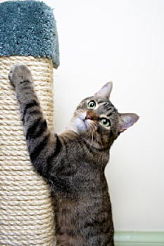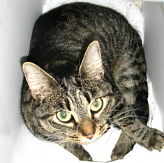Companion Therapy Cats

Companion therapy cats are wonderful. They do wonders with the morale of patients and staff in care facilities, lifting morale and soothing souls. How often have you come home feeling tired after an exhausting day, plunked yourself down on the sofa, and your furry little friend arrives ...begins to purr and jumps on your lap? In no time at all the tension drains away and you feel really relaxed.
Cat owners have long recognized and enjoyed the calming quality of their cats. Some Health-care professionals and cat-owning volunteers are taking this a step further and using the feline's soul-soothing nature as tool for the treatment of psychological and physical ailments. Animal-assisted therapy (AAT) ...in which a credentialed professional guides animal-human interactions toward specific therapeutic goals...is now practiced routinely in hospitals, nursing homes, schools, and correctional facilities nationwide.
Companion therapy cats (or dogs) also visit some facilities as part of less-formal animal-assisted activities (AAA). AAA usually involve "meet and greet" events in which the animal is introduced to an individual or group with no specific therapeutic goal. For example, a volunteer/cat team may visit a nursing home or school to show off some feline tricks or simply to dispense purrs and head rubs. Even though AAA events aren't part of a specific treatment plan, they often do wonders for the morale of patients and staff alike.
Companion therapy cats aren't the only animals used in AAT. Because of their high sociability and train-ability, dogs dominate the ranks of therapy animals. But cats do have certain advantages in therapy settings. Because they are small, quiet, and unobtrusive, cats tend to do well in nursing homes where residents might be put off by a dog's size and activity level. Young children, too, sometimes find fluffy felines less intimidating than large, panting pooches.
The cat's legendary self-reliance may also add to its
appeal. People want to break through the independence and make the cat
dependent. Cats who are very independent around the home often change when they
are in a session. When a cat puts her paw on a person's hand, they just melt.
The cat soothes the soul with gentle purring.
Therapy cats excel at helping people with troubled thoughts. Sometimes, all a cat need do is just be its fuzzy self. There are numerous stories of Alzheimer's patients who wouldn't respond to other people but became mentally focused in the presence of a therapy animal.
The presence of companion therapy cats is often calming. What keeps a person agitated is the angry, depressed or frightened thought stream that continually tells us what to do, but when our attention is directed outward to animals, we shut off that thought stream and it's like medication.
One of the most important benefits of companion therapy cats is that they encourage a type of affectionate physical contact that many patients don't experience. A visit from a therapy animal can have a profound effect on a person's social interactions.
People accompanied by animals become more socially attractive ...as you've no doubt noticed if you've ever tried to carry your cat through a crowd of children. In a clinical setting, a companion therapy cat not only improves social interactions among patients but increased patient/staff communication and morale.
What makes a successful AAA/AAT program is experienced handlers, properly screened cats, and knowledgeable health-care professionals. While almost any cat can be a "love bunny" at home, it takes a special type of feline to be a companion therapy cat.
Some handlers say their cats seem to be natural-born therapists, although upbringing undoubtedly plays a role. Cats that experience extensive human contact during kitten-hood are more likely to tolerate pets and hugs from strangers...which is all in a day's work for a companion therapy cat.
Health AAA/AAT registering organizations require that all therapy animals have a veterinary exam and be up to date on all necessary vaccinations. This requirement is for the safety of patients and for the benefit of the animal. Therapy work can be exhausting for an animal that isn't fit.
Temperament also matters. The Delta Society's Pet Partners Program screens aspiring feline therapists for sociability and affection, tolerance of petting, ability to sit or lie quietly, harness-training and willingness to travel. For instance, a playful cat my be too active for a nursing home.
When you and your cat go to work, make sure you know what's expected of you. It's a good idea to watch an experienced cat-therapy team in action before you make your first visit with your pet.
Follow all the guidelines set forth with the AAT-registering organization and the facility you're visiting and never force your pet's presence on someone who seems unwilling; some people are either allergic to or afraid of cats. Finally, make sure you and your feline enjoy the work. If your cat seems unduly stressed, you should probably let him return to his former employment as a work-at-home therapist.
Related Articles......
Return from Companion Therapy Cats to Cat Health Homepage
Having trouble finding what you need? Cat Health Index & Site Map
OR
Do you have a question to ask?...Questions
OR
Do you have a cat story to share?...Simply click here to go to that page!
Copyright@2010-2020 All rights reserved.Cat-health-detective.com
This website is information only. Consult a veterinarian for medical assistance

"Like Us" on Facebook
or...
"Like Us" here




















